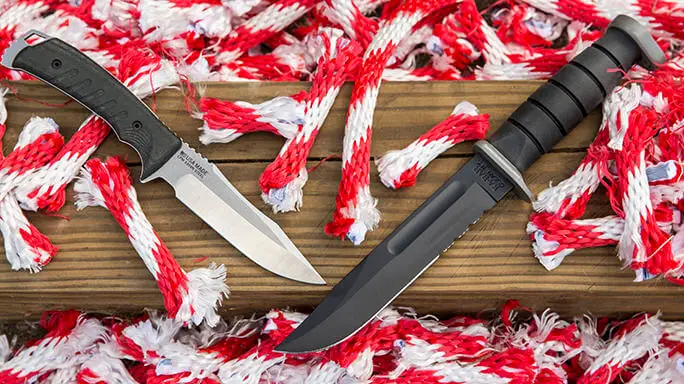A versatile tool and a lethal weapon, not to mention a work of art in and of itself: A good knife can save your life in combat and in outdoor survival scenarios.
Unsure whether to go tactical or combat? We’ve got you covered. Read on for a breakdown of tactical vs. combat knives: Are tactical and combat knives the same thing?
Tactical and Combat Knives: Similarities
Contrary to popular belief, both types aren’t interchangeable: You can use any combat knife as a tactical knife, but the opposite isn’t true. However, they have these features in common.
Blade Material
Carbon steel is your best durable material but is extremely rust-prone. Look for carbon steel coated with stainless steel, which resists corrosion more effectively but tends to dull after heavy use. Damascus steel is both sharp and durable, but it’s harder to find and super-expensive.
You can re-sharpen easily carbon steel with sandpaper, a file, a whetstone, or other types of hones. Keep in mind that none of those will work on stainless steel, which can only be sharpened using ceramic or diamond hones.
Handle Material and Ergonomics
Whether you’re in a combat scenario or you’re hacking away at wood in a wilderness survival scenario, the last thing you need is a wet handle slipping out of your hand. Handles usually come in non-slip material that gives you a strong grip.
A checkered pattern is a great idea, whereas rubber should be avoided: It cracks easily, leaving you with a useless knife.
You should be able to hold the knife comfortably. If the handle design is the wrong size for your hand or is cutting into your palm or fingers, it’s not the right knife for you.
Cutting Edge
Combat knives are expected to do lethal harm if needed, so they come with a super-sharp cutting edge. Similarly, tactical knives should function as saws in an emergency, whether you’re cutting through rope, leather, or other heavy-duty material.
Knives with a serrated edge can stave off dulling longer.
Tactical and Combat Knives: Differences
Here are the main differences between both.
Use:
Tactical knives are versatile tools for everything that isn’t combat. A good tactical knife covers everything from extreme outdoor survival all the way to something as simple as cutting into your steak.
In contrast, combat knives are designed specifically for military use and as a defense weapon. A combat knife can do everything a tactical knife can, but its primary job is self-defense.
Fixed vs. Folding Blade
Tactical knives can be either fixed or folding. A high-quality folding knife is lighter and easier to tuck and carry as a boot knife or pocket knife. There are two downsides, though:
- The folding area is naturally weak
- You’ll need more time to deploy the blade
- They have a length limit
- The locking mechanism can fail or get stuck
Ultimately, the right type depends on your needs. A fixed-blade survival knife is recommended if you expect a self-defense scenario.
Nearly all combat knives come with a fixed blade.
Long vs. Short Blade
Tactical blades come in varying lengths. Although short blades can stab, they’re impractical in a fight. This applies, particularly to folding knives.
Combat knives have longer blades, which can do more harm in a fight.
If you’re considering a tactical knife with a long blade, keep in mind that it can be harder to wield if you’re using it as a utility tool rather than a weapon. No matter how long the blade is or how to mean a knife looks, if it doesn’t sit right in your hand, it’s not the right knife for you.
Versatility
Many tactical knives come with a myriad bells and whistles to help you with survival scenarios, like:
- Bottle opener
- Seat-belt cutter
- Glass breaker
- Battery-operated LED light
- Magnesium fire starter
If you plan on leaving a spare knife in your car, look for one specifically designed to break glass and cut seat belts in case of an accident.
A magnetic tactical knife with an LED light is super-useful: You can slide under your car and stick your knife to the metal, or you can see what you’re doing as you cut wires with your blade. Even better, some brands come with waterproof LED lights.
You can even start a fire easily in the great outdoors using knives equipped with magnesium sticks.
Combat knives will rarely have any of these extra tools, since their primary job is self-defense.
Color
Combat knives are usually unreflective and dark, to avoid catching your enemy’s eye. In contrast, tactical knives can be shiny and even come in bright colors.
Conclusion
Whether it’s a combat knife for self-defense or a tactical knife that doubles as a utility tool, your knife is only as good as your skill in using it. Constant training ensures your safety, be it in combat or as you brave the great outdoors.

